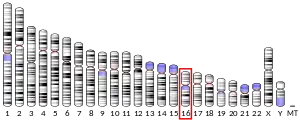| FBXO31 | |||||||||||||||||||||||||||||||||||||||||||||||||||
|---|---|---|---|---|---|---|---|---|---|---|---|---|---|---|---|---|---|---|---|---|---|---|---|---|---|---|---|---|---|---|---|---|---|---|---|---|---|---|---|---|---|---|---|---|---|---|---|---|---|---|---|
| Identifiers | |||||||||||||||||||||||||||||||||||||||||||||||||||
| Aliases | FBXO31, FBX14, FBXO14, Fbx31, pp2386, MRT45, F-box protein 31 | ||||||||||||||||||||||||||||||||||||||||||||||||||
| External IDs | OMIM: 609102 MGI: 1354708 HomoloGene: 11684 GeneCards: FBXO31 | ||||||||||||||||||||||||||||||||||||||||||||||||||
| |||||||||||||||||||||||||||||||||||||||||||||||||||
| |||||||||||||||||||||||||||||||||||||||||||||||||||
| |||||||||||||||||||||||||||||||||||||||||||||||||||
| |||||||||||||||||||||||||||||||||||||||||||||||||||
| Wikidata | |||||||||||||||||||||||||||||||||||||||||||||||||||
| |||||||||||||||||||||||||||||||||||||||||||||||||||
F-box only protein 31 is a protein that in humans is encoded by the FBXO31 gene.[5]
Function
Members of the F-box protein family, such as FBXO31, are characterized by an approximately 40-amino acid F-box motif. SCF complexes, formed by SKP1 (MIM 601434), cullin (see CUL1; MIM 603134), and F-box proteins, act as protein-ubiquitin ligases. F-box proteins interact with SKP1 through the F box, and they interact with ubiquitination targets through other protein interaction domains.[6][5]
F-box protein FBXO31 directs degradation of MDM2 to facilitate p53-mediated growth arrest following genotoxic stress. the F-box protein FBXO31, a candidate tumor suppressor encoded in 16q24.3 for which there is loss of heterozygosity in various solid tumors, is responsible for promoting MDM2 degradation. Following genotoxic stress, FBXO31 is phosphorylated by the DNA damage serine/threonine kinase ATM, resulting in increased levels of FBXO31. FBXO31 then interacts with and directs the degradation of MDM2, which is dependent on phosphorylation of MDM2 by ATM. FBXO31-mediated loss of MDM2 leads to elevated levels of p53, resulting in growth arrest. In cells depleted of FBXO31, MDM2 is not degraded and p53 levels do not increase following genotoxic stress. Thus, FBXO31 is essential for the classic robust increase in p53 levels following DNA damage.[7]
References
- 1 2 3 GRCh38: Ensembl release 89: ENSG00000103264 - Ensembl, May 2017
- 1 2 3 GRCm38: Ensembl release 89: ENSMUSG00000052934 - Ensembl, May 2017
- ↑ "Human PubMed Reference:". National Center for Biotechnology Information, U.S. National Library of Medicine.
- ↑ "Mouse PubMed Reference:". National Center for Biotechnology Information, U.S. National Library of Medicine.
- 1 2 "Entrez Gene: FBXO31 F-box protein 31".
- ↑ Jin J, Cardozo T, Lovering RC, Elledge SJ, Pagano M, Harper JW (November 2004). "Systematic analysis and nomenclature of mammalian F-box proteins". Genes & Development. 18 (21): 2573–80. doi:10.1101/gad.1255304. PMC 525538. PMID 15520277.
- ↑ Malonia SK, Dutta P, Santra MK, Green MR (July 2015). "F-box protein FBXO31 directs degradation of MDM2 to facilitate p53-mediated growth arrest following genotoxic stress". Proceedings of the National Academy of Sciences of the United States of America. 112 (28): 8632–7. Bibcode:2015PNAS..112.8632M. doi:10.1073/pnas.1510929112. PMC 4507212. PMID 26124108.
Further reading
- Hartley JL, Temple GF, Brasch MA (November 2000). "DNA cloning using in vitro site-specific recombination". Genome Research. 10 (11): 1788–95. doi:10.1101/gr.143000. PMC 310948. PMID 11076863.
- Powell JA, Gardner AE, Bais AJ, Hinze SJ, Baker E, Whitmore S, Crawford J, Kochetkova M, Spendlove HE, Doggett NA, Sutherland GR, Callen DF, Kremmidiotis G (September 2002). "Sequencing, transcript identification, and quantitative gene expression profiling in the breast cancer loss of heterozygosity region 16q24.3 reveal three potential tumor-suppressor genes". Genomics. 80 (3): 303–10. doi:10.1006/geno.2002.6828. PMID 12213200.
- Wiemann S, Arlt D, Huber W, Wellenreuther R, Schleeger S, Mehrle A, Bechtel S, Sauermann M, Korf U, Pepperkok R, Sültmann H, Poustka A (October 2004). "From ORFeome to biology: a functional genomics pipeline". Genome Research. 14 (10B): 2136–44. doi:10.1101/gr.2576704. PMC 528930. PMID 15489336.
- Kumar R, Neilsen PM, Crawford J, McKirdy R, Lee J, Powell JA, Saif Z, Martin JM, Lombaerts M, Cornelisse CJ, Cleton-Jansen AM, Callen DF (December 2005). "FBXO31 is the chromosome 16q24.3 senescence gene, a candidate breast tumor suppressor, and a component of an SCF complex". Cancer Research. 65 (24): 11304–13. doi:10.1158/0008-5472.CAN-05-0936. PMID 16357137.
- Mehrle A, Rosenfelder H, Schupp I, del Val C, Arlt D, Hahne F, Bechtel S, Simpson J, Hofmann O, Hide W, Glatting KH, Huber W, Pepperkok R, Poustka A, Wiemann S (January 2006). "The LIFEdb database in 2006". Nucleic Acids Research. 34 (Database issue): D415–8. doi:10.1093/nar/gkj139. PMC 1347501. PMID 16381901.



